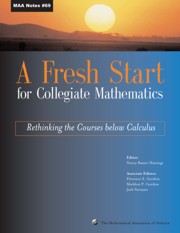Book contents
- Frontmatter
- Preface
- Contents
- Introduction
- Background
- Theme 1 New Visions for Introductory Collegiate Mathematics
- Theme 2 The Transition from High School to College
- Theme 3 The Needs of Other Disciplines
- Theme 4 Student Learning and Research
- Theme 5 Implementation
- Theme 6 Influencing the Mathematics Community
- Ideas and Projects that Work: Part 1
- Ideas and Projects that Work: Part 2
Theme 3 - The Needs of Other Disciplines
- Frontmatter
- Preface
- Contents
- Introduction
- Background
- Theme 1 New Visions for Introductory Collegiate Mathematics
- Theme 2 The Transition from High School to College
- Theme 3 The Needs of Other Disciplines
- Theme 4 Student Learning and Research
- Theme 5 Implementation
- Theme 6 Influencing the Mathematics Community
- Ideas and Projects that Work: Part 1
- Ideas and Projects that Work: Part 2
Summary
As Deborah Hughes Hallett observes in her paper, “What Have We Learned from the Calculus Reform Movement?” (which appears earlier in this volume): “In the long run, the largest impact of calculus reform is likely to be the creation of a community of mathematicians who innovate and reflect on their teaching—and who do so in collaboration with faculty in other disciplines and across institutional boundaries.” One of the challenges confronting refocusing the courses below calculus is for mathematicians to understand and to respond to the needs of partner disciplines. The three papers in this section address this challenge. Bill Barker and Susan Ganter summarize the outcomes of the Curriculum Foundations Project, which held a series of eleven disciplinary workshops that focused on the needs of the partner disciplines during the first two years of undergraduate instruction. Rich West notes that as a result of a new curriculum, which was introduced in 1990, the senior leadership at West Point strived to find a balance between teaching students concepts and helping them master skills. He describes the compromise that resulted after many discussions with their partner disciplines. Allan Rossman observes that many calculus reform projects emphasize applications, which in turn often involve genuine data. He argues that the use of real data is an important aspect of refocusing precalculus.
Bill Barker and Susan Ganter describe the portions of the Curriculum Foundations Project that are most relevant to college algebra and precalculus.
- Type
- Chapter
- Information
- A Fresh Start for Collegiate MathematicsRethinking the Courses below Calculus, pp. 151 - 152Publisher: Mathematical Association of AmericaPrint publication year: 2006

